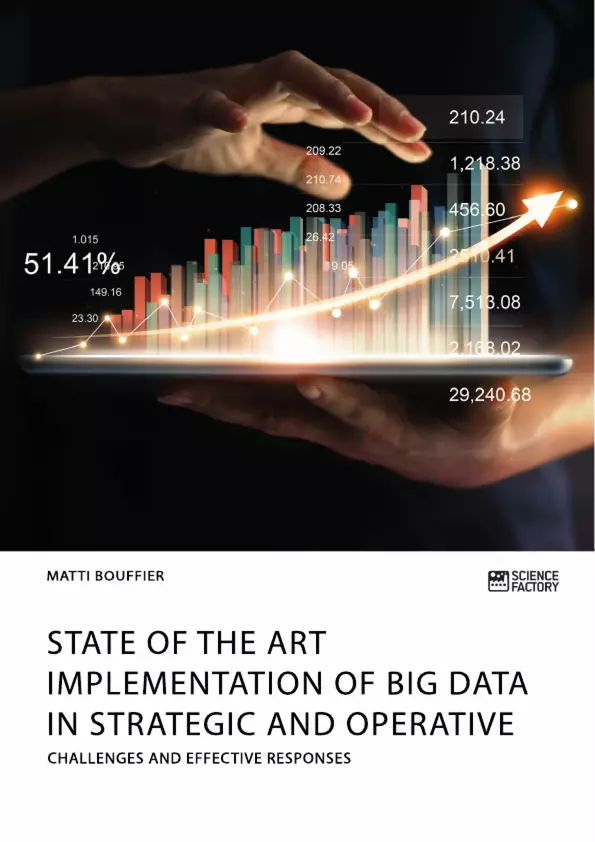"Data is the new gold" and "The world's most valuable resource is no longer oil, but data" – Headlines like these, published by The Economist and the World Economic Forum in 2017 and 2020, underline the crucial role data plays in business nowadays. Big Data has become the "Holy Grail" for health, security, administration, and marketing businesses.
This paper seeks to understand the significance of Big Data for the marketing sector. How is the state of the art regarding the implementation of Big Data supporting and enhancing strategic as well as operative marketing activities? Which challenges are companies facing while adopting Big Data, and how can they respond most effectively to them?
Matti Bouffier explores the potentials and challenges of Big Data by providing a well-researched theoretical elaboration of the technological dimensions of Big Data implementation. His analysis is supported by expert interviews, which further illuminate the impact Big Data has on real-life marketing business. By bridging the gap between theory and praxis, Bouffier is able to give recommendations for how to address the main challenges and harness the potentials of Big Data implementation.
Inside the book:
- Data-driven marketing;
- Big Data in marketing;
- Challenges;
- Correlation-driven analysis;
- Causality-driven analysis
Inhaltsverzeichnis (Table of Contents)
- 1 Introduction
- 1.1 Research background
- 1.2 Purpose and research objective
- 1.3 Methodology and structure
- 2 Theoretical background of data-driven marketing
- 2.1 From database marketing to data-driven marketing
- 2.2 Big Data
- 3 State of the art regarding implementation of Big Data in marketing
- 3.1 State of the art marketing research
- 3.2 State of the art target marketing
- 4 Challenges of successful Big Data implementation
- 4.1 Strategic approach
- 4.2 Data regulations and privacy
- 4.3 Human resources, internal structures, and corporate culture
- 4.4 Technical infrastructure and centralizing data
- 4.5 Data quality and data volume
- 4.6 Acceptance and focus on new Big Data processes
- 4.7 Correlation-driven analysis vs. causality-driven analysis
- 4.8 Courage for trial and error
- 5 Conclusion, recommendation, and outlook
Zielsetzung und Themenschwerpunkte (Objectives and Key Themes)
This work examines the implementation of big data in strategic and operative marketing. It aims to analyze current approaches and identify challenges and effective responses to overcome them. The research focuses on exploring how organizations can leverage big data to optimize their marketing efforts.
- State-of-the-art implementation of big data in marketing
- Challenges of successful big data implementation
- Effective responses to overcome big data implementation challenges
- Strategic approach to big data implementation
- Data regulations and privacy considerations in big data marketing
Zusammenfassung der Kapitel (Chapter Summaries)
The first chapter introduces the research background, objective, and methodology of the study. The second chapter provides a theoretical foundation of data-driven marketing, discussing its evolution from database marketing and the concept of big data. Chapter three delves into the current state of the art regarding big data implementation in marketing, exploring existing research and target marketing practices. Chapter four examines the challenges faced in successfully implementing big data in marketing, covering aspects such as strategic approach, data regulations and privacy, human resources, technical infrastructure, data quality, acceptance, and analytical approaches.
Schlüsselwörter (Keywords)
This work focuses on the integration of big data in marketing, encompassing key terms such as data-driven marketing, big data analytics, marketing research, target marketing, strategic implementation, data regulations, privacy, human resources, technical infrastructure, data quality, and analytical approaches.
- Quote paper
- Matti Bouffier (Author), 2021, State of the Art Implementation of Big Data in Strategic and Operative Marketing. Challenges and Effective Responses, Munich, GRIN Verlag, https://www.grin.com/document/1025936



